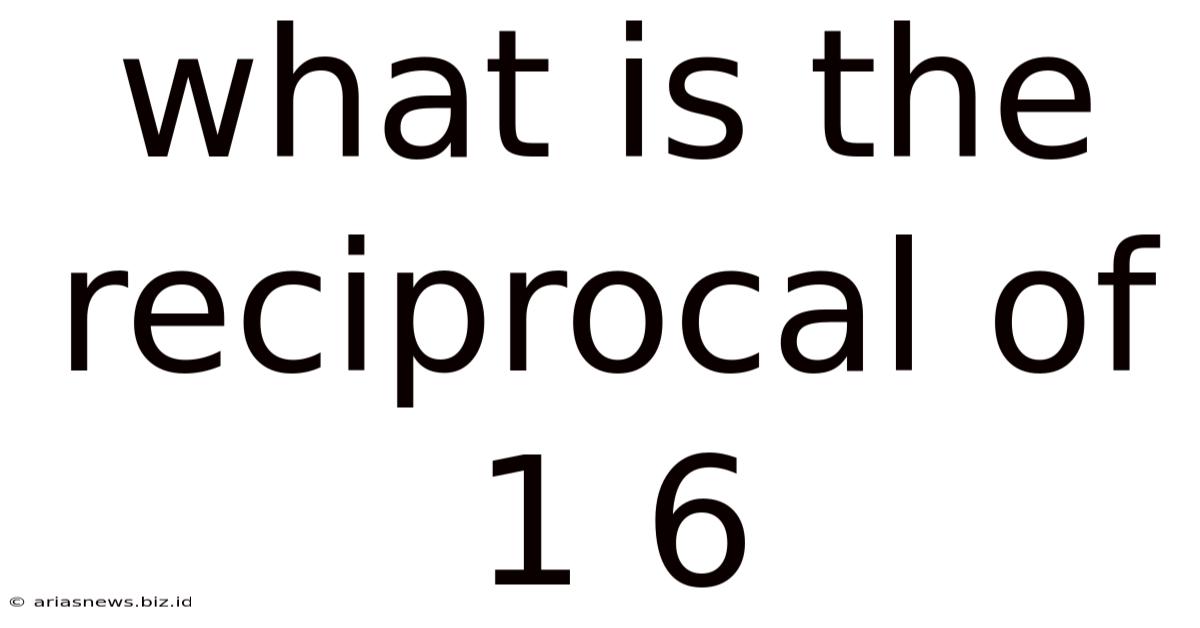What Is The Reciprocal Of 1 6
Arias News
May 11, 2025 · 4 min read

Table of Contents
What is the Reciprocal of 1/6? A Deep Dive into Reciprocals and Their Applications
The question, "What is the reciprocal of 1/6?" might seem simple at first glance. However, understanding reciprocals goes beyond a simple calculation; it unlocks a deeper understanding of fundamental mathematical concepts with wide-ranging applications in various fields. This article will not only answer the question directly but will also delve into the meaning of reciprocals, their properties, and their significance in mathematics and beyond.
Understanding Reciprocals: The Flip Side of Numbers
A reciprocal, also known as a multiplicative inverse, is a number that, when multiplied by the original number, results in a product of 1. In simpler terms, it's the number you need to multiply a given number by to get 1. Finding the reciprocal involves "flipping" the numerator and the denominator of a fraction.
For example:
- The reciprocal of 2 (or 2/1) is 1/2, because 2 * (1/2) = 1.
- The reciprocal of 5/7 is 7/5, because (5/7) * (7/5) = 1.
- The reciprocal of 1 is 1, because 1 * 1 = 1.
Important Note: Zero does not have a reciprocal. There is no number you can multiply by zero to get 1. This is because any number multiplied by zero equals zero.
Calculating the Reciprocal of 1/6
Now, let's tackle the original question: What is the reciprocal of 1/6?
To find the reciprocal of 1/6, we simply "flip" the fraction:
The reciprocal of 1/6 is 6/1, which simplifies to 6.
Therefore, 1/6 multiplied by 6 equals 1: (1/6) * 6 = 1.
Reciprocals and Fractions: A Closer Look
Understanding reciprocals is crucial when working with fractions. Many mathematical operations, particularly division, rely heavily on the concept of reciprocals. Dividing by a fraction is equivalent to multiplying by its reciprocal. This is a fundamental principle used extensively in algebra and calculus.
For instance:
(1/2) ÷ (1/4) = (1/2) * (4/1) = 4/2 = 2
Here, we replaced division by 1/4 with multiplication by its reciprocal, 4/1 (or 4).
Applications of Reciprocals in Real-World Scenarios
Reciprocals are not merely abstract mathematical concepts; they have practical applications in various fields:
1. Physics and Engineering
- Calculating speeds and rates: Reciprocals are used extensively in physics to calculate speeds, rates, and other physical quantities. For example, if you know the time it takes to travel a certain distance, you can use the reciprocal of the time to find the speed.
- Electrical circuits: In electrical engineering, reciprocals are used to calculate impedance and resistance in circuits.
- Optics: Reciprocals are used in calculations related to lens magnification and focal length.
2. Finance and Economics
- Interest rates: Reciprocals can be utilized in calculations involving compound interest and other financial formulas.
- Economic modeling: Reciprocals can help in understanding and modeling economic phenomena involving rates of change.
3. Computer Science and Programming
- Data structures: Reciprocals can play a role in algorithms involving data structures and graph theory.
- Image processing: Reciprocals can be used in image processing algorithms for scaling and resizing.
4. Chemistry
- Chemical reactions: Reciprocals can help calculate reaction rates and stoichiometry in chemical reactions.
5. Everyday Life
- Recipes: When halving or doubling recipes, you're implicitly using reciprocals to adjust ingredient quantities.
- Travel: Calculating travel time based on distance and speed involves the use of reciprocals.
Exploring More Complex Examples
While the reciprocal of 1/6 is straightforward, let's consider more complex scenarios involving mixed numbers and negative numbers:
Reciprocals of Mixed Numbers
To find the reciprocal of a mixed number, first convert it to an improper fraction. Then, flip the numerator and denominator.
For example, let's find the reciprocal of 2 1/3:
- Convert 2 1/3 to an improper fraction: (2 * 3 + 1)/3 = 7/3
- The reciprocal of 7/3 is 3/7.
Reciprocals of Negative Numbers
The reciprocal of a negative number is a negative number. Simply find the reciprocal of the absolute value and then add the negative sign.
For example, the reciprocal of -5 is -1/5.
Reciprocals and the Concept of Inverses
The reciprocal is a specific type of inverse. In mathematics, an inverse is an operation that "undoes" another operation. Addition and subtraction are inverses, as are multiplication and division. The reciprocal is the multiplicative inverse, meaning it "undoes" multiplication.
Conclusion: The Importance of Mastering Reciprocals
Understanding reciprocals is fundamental to a solid grasp of mathematical concepts. From solving simple fractions to tackling complex equations in advanced mathematics, physics, and engineering, the concept of reciprocals is indispensable. Its applications extend far beyond the classroom, permeating numerous fields and impacting everyday life. Mastering reciprocals unlocks a deeper understanding of the interconnectedness of mathematical principles and their practical applications in the real world. By consistently practicing and applying this concept, you will build a stronger foundation for mathematical problem-solving and broaden your capabilities in various fields. Remember, even the simplest concepts, like finding the reciprocal of 1/6, can be a gateway to more advanced and fascinating mathematical explorations.
Latest Posts
Latest Posts
-
How Many Pairs Of Parallel Sides Are In A Trapezoid
May 12, 2025
-
How Much Does A Drop Of Water Weigh
May 12, 2025
-
How To Calculate The Rf Value In Chromatography
May 12, 2025
-
What Is The Gcf Of 24 And 9
May 12, 2025
-
Express The Decimal 2 39 As A Percent
May 12, 2025
Related Post
Thank you for visiting our website which covers about What Is The Reciprocal Of 1 6 . We hope the information provided has been useful to you. Feel free to contact us if you have any questions or need further assistance. See you next time and don't miss to bookmark.